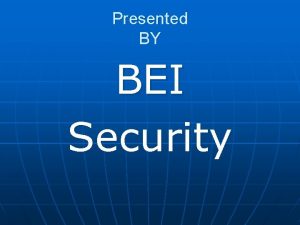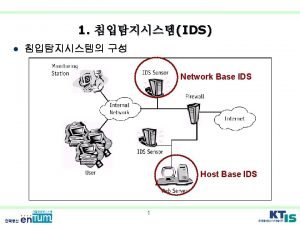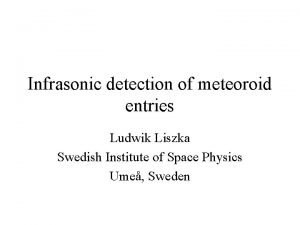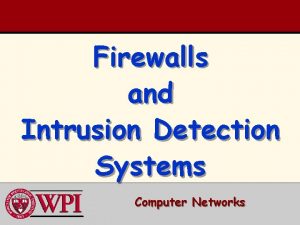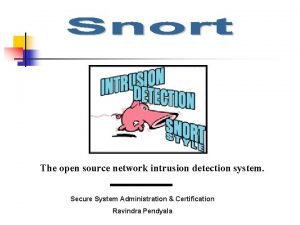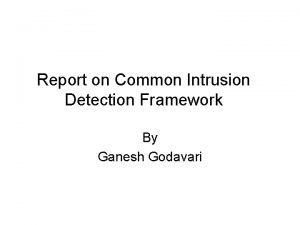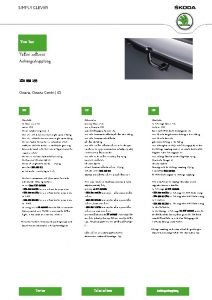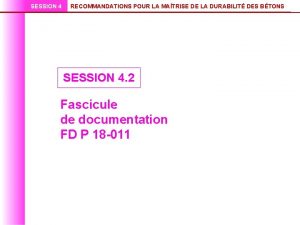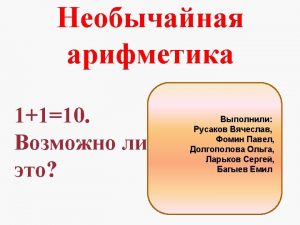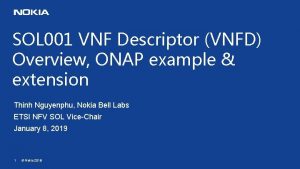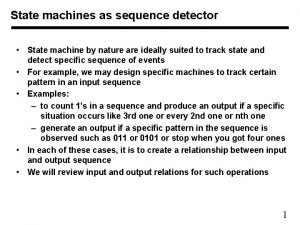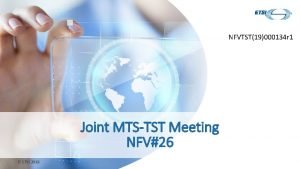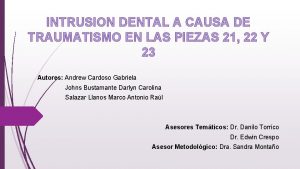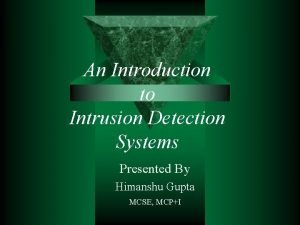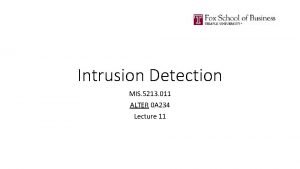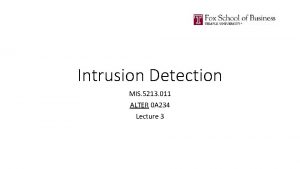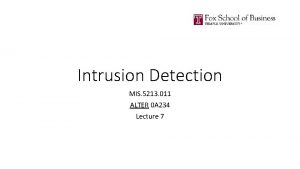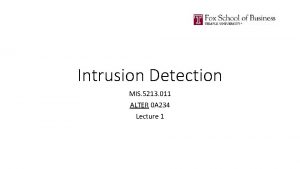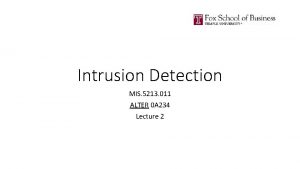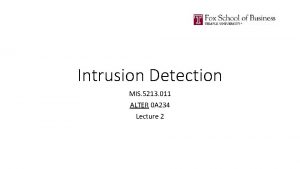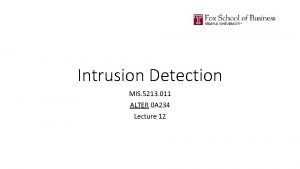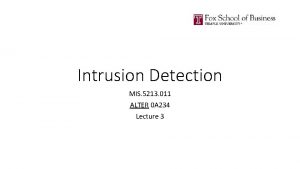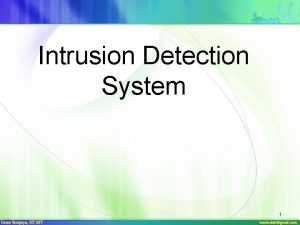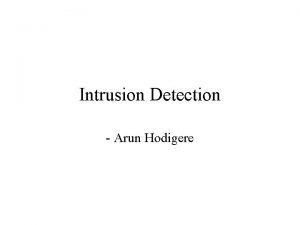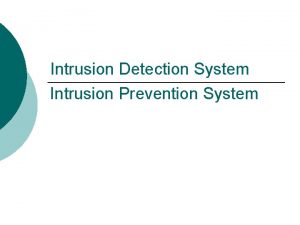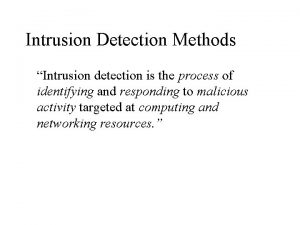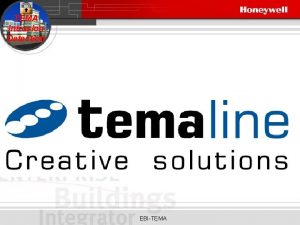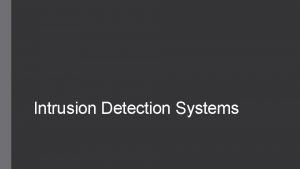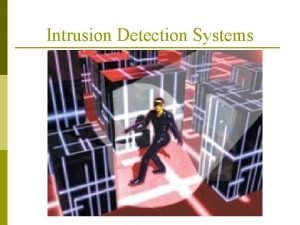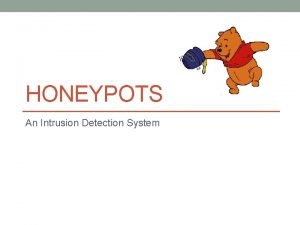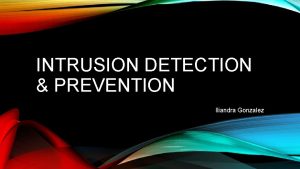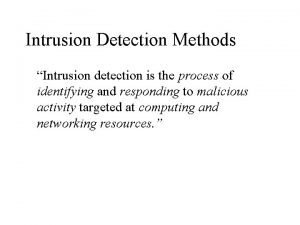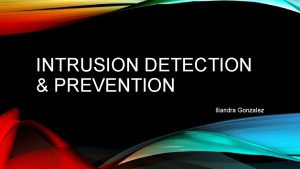Intrusion Detection MIS 5213 011 ALTER 0 A































- Slides: 31

Intrusion Detection MIS. 5213. 011 ALTER 0 A 234 Lecture 2

Incident Response Plan (IRP) Preparation Identification Containment & Escalation Analysis & Eradication Recovery Lessons Learned Plan PRIOR to Incident Determine what is/has happened Limit incident [If data breach] Determine and remove Notification root cause Return operations to normal Process improvement: Plan for the future Ex-Post Response Notify any data breach victims Establish call center, reparation activities

Lecture Objectives • Topics for lecture 2 • Relevant Documents • Incident Response Plans – Continued • Sample Incident Response Plans • Building IRTs (Roles and Responsibilities) • Activity – Identification of roles and responsibilities

Documents • What are the relevant documents • • • Sample Policies Asset Inventory System Recovery Documents Roles and Responsibilities Notification Call Tree Sample Reports

Policies • What kind of policies will be relevant for a successful Incident Response • Acceptable Use Policy – How can corporate assets and infrastructures are to be used. • Remote Access Policy – How can corporate assets are access remotely and protected when accessed remotely • Information Security Policy – How critical assets are to protected • Awareness Policy – How the users of critical assets will be trained on the use, handling, and what are the risks. • Any others? ? ?

Components of Effective Policies • What are the components of the effective policies • Clear / Concise Policy Statement • Identifies the scope (Who the policy applies to and what systems are covered under the policy) • Enforcement Clause • Purpose of the policy • Guidance – How to comply • Signed off by Most Senior management • Updated periodically

Asset Inventories • What kinds of information should be recorded or tracked for tracking inventory • • Name / System – IP Address Geogrpahic locations What businesses are supported Criticality Data Classification Where are the system recovery documents? Any thing else? ? ?

Develop IRT • How is an IRT developed • • What is the mission Identify the Stake holders Identify skills needed to deal with an intrusion Identify the communication Procedures

What is the mission • The mission may include all or some of the following • Respond to all security incidents or suspected incidents using an organized investigative process. • Conduct a complete impartial investigation • Quickly confirm or dispel whether an intrusion or security incident has occurred • Assess the damage • Control and contain the incident • Collect and document all evidence related to the incident • Protect privacy rights protected by law or corporate privacy • Maintain the confidentiality to protect the organization

Communication Procedures • Types of communications • • • Emails Adhoc Conference Calls Press Releases Notifications to victims Sharing of information with External Parties • What information will be shared • Who will provide that communications

Team Roles • Intrusion Manager - Team Manager • Administrative and Personnel Management • Reports to CISO / CIO • Communicates to other stake holders • Intrusion Specialist – Team Leader • Coordinates a Specific Incident • Senior Incident Handler • Reports to Intrusion Manager • Analyst • Incident Responder • SME – Called upon based on the incident • Strong technical skills • Equipment Manager • Responsible for maintaining all Intrusion equipment • Reports to Intrusion Manager • Dotted line to Intrusion Specialist

Team Roles • HR Representative • Provides Guidance and counsel on Employee matters • Legal Representative • • Provides legal guidance Interacts with law enforcement entities Ensures Chain of Custody is maintained with evidence Helps draft contracts with outside vendors as needed • Public Relations Representative • Provides the face to the incident and represents the company to the public, community, news, etc. Many times it is the attorney.

Notification Call tree • Following questions need to be answered • Who Activates the IRT? • • Help Desk IT Managers Senior Managers Users ? ? • Once the IRT has been activated • Who calls whom?

Communications • Additional things to consider • When does the incident meet a reporting threshold? • Immediately, • within 24 hours, • after intrusion has been eradicated? • When communicating to external party, what contract language is in place to protect • confidentiality • Against law suits • Improper disclosures • Which laws are impacted

Team Resources • Is the team adequately funded • Does the team have adequate resources • Funding stream, approvals, credit cards, etc. • Is the team adequately skilled • • • In-house training Outside training Annual training budget Cross Training Has a skills gap analysis been conducted Do we have contracts in place with outside vendors with the right skills

Preparing the infrastructure • Detecting an incident is heavily dependent on how the infrastructure has been configured • Hosts • Network Architecture • Logging

Hosts • Are all of the assets accounted for • • • Servers Desktops Laptops Printers Mobile Devices • Have all of the systems been hardened • While all of the hardening the systems is important, are the systems logging enabled. • Have all of the systems been baselined ** • Have all of the systems been surveyed • OS, Hardware, Security Software, Applications, Business Applications, DBs, Local and Networked

Networks • Are all of the assets accounted for • • • Switches Wireless Access Points DMZ Routers Firewalls Anti. Virus Authentication Servers VPN Concentrators Etc. . • Have all of the systems been hardened • While all of the hardening the systems is important, are the systems logging enabled. • Have all of the systems been baselined ** • Have all of the systems been surveyed

Networks • Has the network been segmented • • VLANs Firewalls, ACLs Etc. . • In order to minimize the impact of an intrusion, the network should be segmented • Based on the information being processed • Based on role & the criticality of the systems • Have different zones been created and traffic controlled between zones.

Logging • Has logging been turned on all hosts and network devices • Are all of the logs being sent to a log collector • Is the log collector configured to protect the access from all users including the admins. • What is the retention policy for logs • What is the backup policy for log server • Who has logical and physical access to logs • Is there ample physical security for the logs • UTC? ? ?

Starting the investigation • Investigation should began with clear, precise and accurate information. • Creating Checklist to help get investigations started. • • • Incident Summary How the incident was detected System Details Network Details Malware Details

Incident Summary Date and Time the incident was reported Date and Time the incident was detected Contact info: individual completing the checklist Contact info: individual who reported the incident Contact info: individual who detected the incident Nature of the incident (virus, malware, spear phishing, failed logon, etc) Type of affected resource How the incident was detected (brief summary) Computer ID – Host Name, HW Address, IP Address, etc, Location, Data port / switch port, etc. • Who has access to system before and after the incident • Is the incident ongoing • Sensitivity of the incident • • •

Incident Detection Checklist • Was the detection manual or automated • What information was part of the initial detection (alert, person, etc) • What sources provided the data that contributed to the detection ? (Network utilization, file size, person noticing an odd glitch, etc) • Has the incident been validated as accurate: Raw data compared with an alert, detection methodologies scrutinized • Has the source data been preserved? • How long has the detection system been online? • What are the detection rates of the detection system?

Individual System Details • • • • Physical Location Asset Tag System’s make and model Operating System installed Primary function of the system System Administrator for the system Assigned IP address (if static) – Lease assignment for DHCP (Lease details) System host name and Domain Type of Information Stored on the system If there are backups, where are they Is the system still connected to the network List of any malware detected List of any remediation steps that have been taken Has any data been saved or backed up since incident and where are the backups kept.

Network Details • • List of all external malicious IP addresses and domain anmes Whether network monitoring is being conducted List of remediation steps that has been taken Network diagrams and updates.

Malware Details • • Date and time of detection How the malware was detected List of systems where malware was found Name of the malicious file and the directory it was present in If malware is active, are there any active network connections Copy of the malware if it has been preserved. Status of any analysis Was the malware submitted to third parties

Development of Leads • Leads: Actionable items about stolen data, network indicators, identities of potential subjects, or issues that led to the compromise or an incident. • A good lead has three characteristics • Lead must be relevant • Lead must be actionable • Lead must have sufficient detail • Following operations should be done on leads before investing resouces on them • Clarify the data • Verify the veracity of the lead • Determine the context of the lead

Leads into IOCs • Most leads should consist of detectable characteristics of malicious actions. • Two types of indicators • Property Based : describes a set of known observable characteristics of malicious software or actions • A registry key • MD 5 hash • Methodology based – Anomaly based: leads are less specific, where a combination of characteristics can define a malicious or suspicious act • IOC : Indicators of Compromise • http: //www. openioc. org/ • IOC stands for Indicators of Compromise. The term may be used to refer to specific artifacts left by an intrusion, or greater sets of information that allow for the detection of intrusions or other activities conducted by attackers. The term is also used as the name for a file in the Open. IOC format that contains a set of data. The file extension for such files is. ioc. (Source: www. openioc. org)

Usings IOCs • IOCs utilize XML to create a signature of an intrusion. • IOCs are created using IOC editors • The IOCs are then used to sweep the enterprise and to look for similar patterns. Computers with similar characteristics are identified, and taken down for cleanup.

Resolving Internal Leads • Non – System leads (humans) • • Thoroughly document all interviews and statements Listen more than talk Avoid leading questions / avoid questions with yes / no answers Collect the facts before opinions

Resolving External Leads • When dealing with external leads – legal may need to get involved. • Hardest part will be to get someone to talk.
 Fiber optic perimeter intrusion detection systems
Fiber optic perimeter intrusion detection systems Intrusion detection systems (ids)
Intrusion detection systems (ids) Infrasonic intrusion detection
Infrasonic intrusion detection Ids sensors
Ids sensors Intrusion prevention system open source
Intrusion prevention system open source Bro intrusion detection
Bro intrusion detection Common intrusion detection framework
Common intrusion detection framework Tan track bar
Tan track bar Fd p 18-011
Fd p 18-011 000 111 000
000 111 000 Rmer-011
Rmer-011 Global trade repository
Global trade repository 00 000 011 10 11 1000 11
00 000 011 10 11 1000 11 Vnfd example
Vnfd example 011 101 110
011 101 110 011 sequence detector
011 sequence detector Etsi gs nfv-ifa 011
Etsi gs nfv-ifa 011 Ggg-p2-011
Ggg-p2-011 Let 011 unidad iv ejercicios
Let 011 unidad iv ejercicios Nem 011
Nem 011 Umask 011
Umask 011 Mis mai a mis tachwedd
Mis mai a mis tachwedd Principios proyecto de vida
Principios proyecto de vida Mis actos son un reflejo de mis creencias
Mis actos son un reflejo de mis creencias Mi ____ es el hijo de mi tío.
Mi ____ es el hijo de mi tío. Mis mai a mis tachwedd
Mis mai a mis tachwedd Golden ticket attack detection
Golden ticket attack detection Skewards
Skewards Intrusion movie
Intrusion movie Inmersive portals
Inmersive portals S italica odontologia
S italica odontologia Analysis console for intrusion databases
Analysis console for intrusion databases
